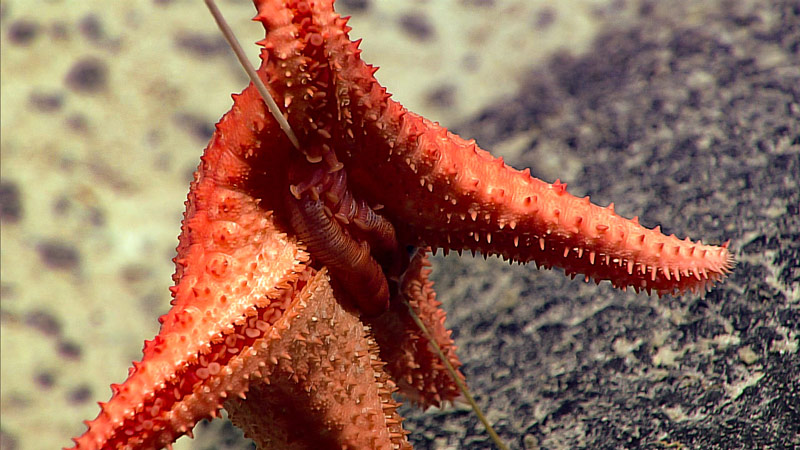
A sea star eats its way up a whip coral. Image courtesy of the NOAA Office of Ocean Exploration and Research, Deepwater Wonders of Wake. Download larger version (jpg, 1.4 MB).

A sea star eats its way up a whip coral. Image courtesy of the NOAA Office of Ocean Exploration and Research, Deepwater Wonders of Wake. Download larger version (jpg, 1.4 MB).
Dive 7: Predation
A sea star eats its way up a whip coral in this closeup example of underwater predation. Video courtesy of the NOAA Office of Ocean Exploration and Research, Deepwater Wonders of Wake. Download larger version (mp4, 52.1 MB).
We conducted Dive 7 the side of a rift zone crest of another unnamed seamount 130 miles south of Wake Island. The depth range for the dive was between 2,100 and 1,900 meters. The first view of the ocean floor showed a relatively steep wall of pillow lavas coated in thick manganese (Mn) crust. The pillows were still visible as 10-50 centimeter sized "bumps"under the thick, smooth Mn crust. As we ascended to the ridge crest, it became fairly clear that the entire wall section was a large structure built from mainly pillow lavas (and some tube lavas). Only infrequent loose rocks were observed (likely displaced). Near the ridge crest and on top of it, the sediment load increased somewhat, particularly in the less steep sections along the crest. On the wall, the initial density of animals was moderate, with us mainly finding them on small knobs and boulders that were providing some distance from the main seafloor. As we entered the ridge crest, the density of animals increased, particularly on the harder surfaces, though still on the higher boulders and knobs. In addition to several types of sponges seen in the previous dives, an unknown small, wide-stick-type sponge was observed several times; however, its identity could not be deduced even to class. On the ridge crest, bottle-brush Chrysogorgia sp. were the most dominant animal.